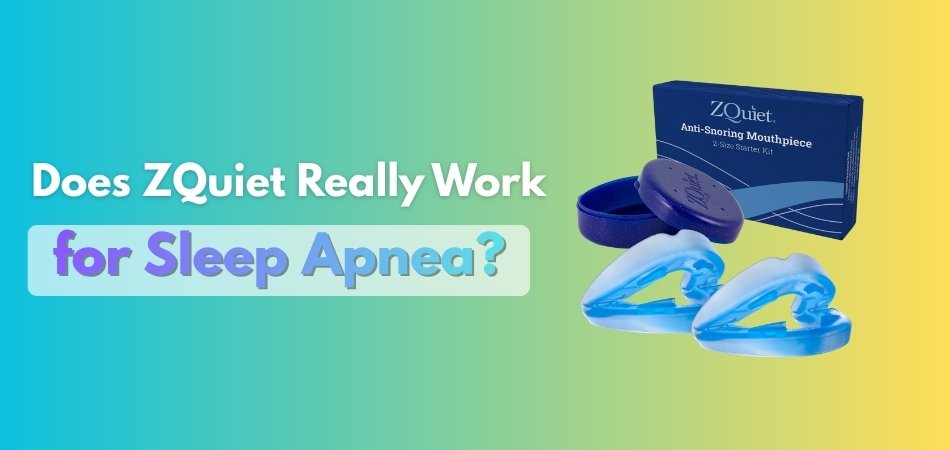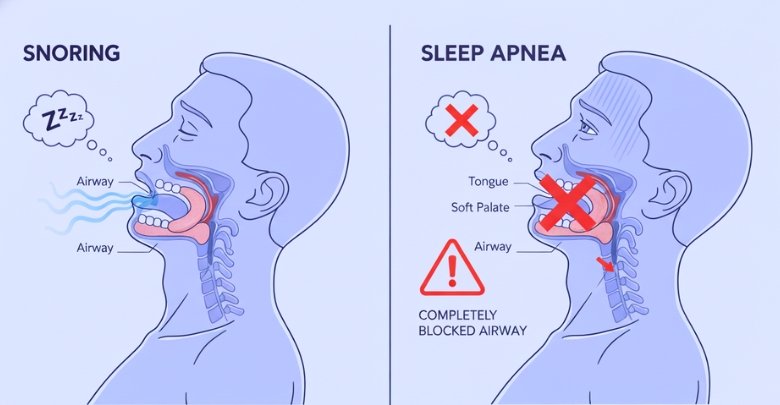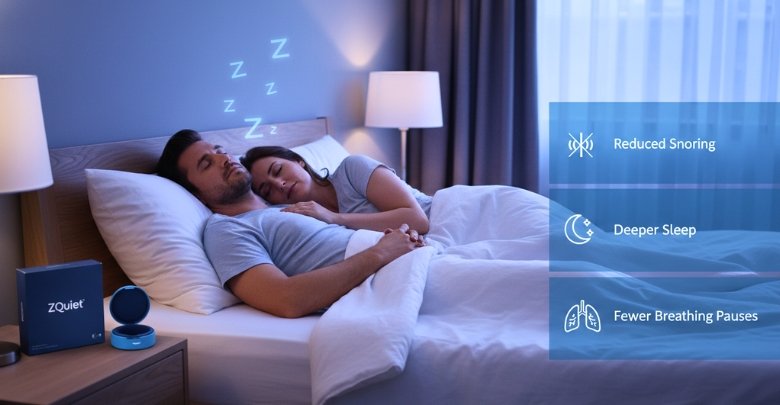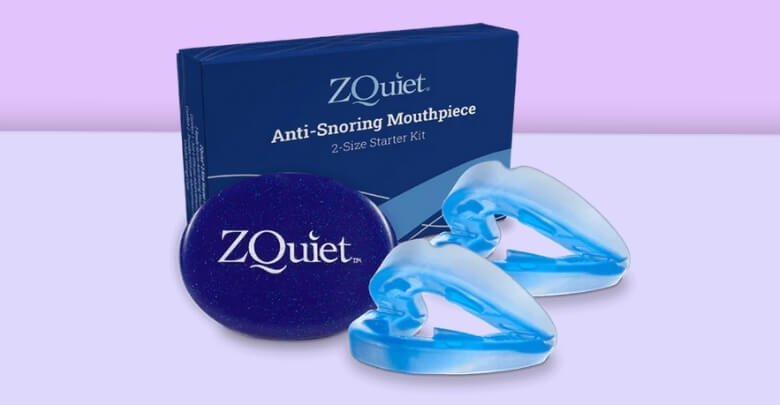Sleep apnea can turn peaceful nights into exhausting struggles, leaving you feeling unrested even after hours of sleep. Many people turn to mouthpieces for relief, and one name that often stands out is ZQuiet. But the real question remains: Does ZQuiet really work for sleep apnea?
ZQuiet is designed to improve airflow by slightly adjusting your jaw position while you sleep. This small change helps keep the airway open, reducing snoring and breathing pauses. While results vary from person to person, many users report noticeable improvements in sleep quality and comfort.
If you’ve been searching for an easier and more comfortable alternative to bulky machines, this guide will help you decide. Continue reading to discover how ZQuiet actually helps and whether it could be the right choice for your sleep needs.
Does ZQuiet Really Work for Sleep Apnea?
Sleep apnea happens when breathing repeatedly stops during sleep, leaving many people restless and exhausted. ZQuiet is a mouthpiece developed to help improve airflow by gently adjusting the jaw position. It provides a more comfortable and portable solution compared to traditional machines used for sleep apnea relief. Let’s explore the ways this device can help manage symptoms and improve sleep quality.

Improves Airway Flow
ZQuiet works by slightly moving the lower jaw forward to create more space in the airway. This position helps prevent the soft tissues in the throat from collapsing during sleep. As a result, air can pass through more freely, allowing consistent breathing and minimizing the interruptions that commonly occur in sleep apnea.
Reduces Snoring and Breathing Pauses
By keeping the airway clear, ZQuiet minimizes the vibration that causes snoring and reduces pauses in breathing. Users often experience fewer nighttime awakenings and deeper rest. Consistent airflow not only improves sleep but can also contribute to better oxygen levels and morning alertness, making it easier to wake up refreshed.
Enhances Comfort with Flexible Design
Unlike many rigid mouthpieces, ZQuiet is made from a flexible material that adjusts naturally with jaw movement. This design allows users to speak or sip water without removing the device. The lightweight construction provides comfort throughout the night, which encourages consistent use, an important factor in improving long-term sleep quality and breathing patterns.
Backed by Clinical Insight and User Feedback
According to many experiences shared in ZQuiet review discussions, users with mild to moderate sleep apnea have noticed meaningful improvement. Clinical studies support its ability to aid airway function safely. While it’s not a substitute for medical-grade treatments in severe cases, it remains an effective, affordable solution for everyday snoring and mild apnea relief.
ZQuiet can help improve breathing comfort and sleep quality for many users experiencing mild sleep apnea. Next, let’s look at the link between snoring and sleep apnea to understand why addressing one can often improve the other.
Understanding the Connection Between Snoring and Sleep Apnea
Snoring is often seen as a harmless habit, but it can be a sign of a more serious condition known as sleep apnea. Both involve restricted airflow during sleep, yet their severity and impact differ. To see how this relationship works, let’s explore the main differences and physiological reasons behind both conditions.

Snoring and Sleep Apnea Are Not the Same
Snoring occurs when air passes through a partially blocked airway, causing vibrations in the throat tissues. Sleep apnea, however, involves complete pauses in breathing for several seconds. While snoring may seem less serious, persistent or loud snoring can indicate that the airway is collapsing enough to disrupt breathing patterns during sleep.
Airway Obstruction and Muscle Relaxation
Both conditions stem from restricted airflow during rest. When throat muscles relax too much, the airway narrows, and the tongue may fall back, partially blocking air movement. This obstruction leads to snoring sounds or complete pauses in breathing. Understanding this mechanism helps identify why opening the airway can reduce both snoring and mild apnea symptoms.
Treating Snoring May Also Help Sleep Apnea
Managing snoring often improves airflow and reduces nighttime breathing interruptions. Devices like ZQuiet, which reposition the jaw slightly forward, keep the airway open for smoother breathing. While it may not cure severe apnea, improving snoring can prevent mild cases from worsening and help users experience deeper, uninterrupted sleep more consistently.
While snoring and sleep apnea differ in intensity, they share the same root cause, restricted airflow. Addressing snoring early can be a proactive step toward preventing more serious breathing disorders and improving overall sleep quality. Next, we’ll discuss who should consider using ZQuiet for better sleep results.
Who Should Consider Using ZQuiet for Better Sleep?
ZQuiet is ideal for individuals seeking an easier and more comfortable way to manage snoring or mild sleep apnea. It provides an alternative to traditional treatments by focusing on improving airflow naturally through jaw positioning. Before choosing ZQuiet, let’s understand who can benefit the most and who should use it with caution.
- Mild to Moderate Sleep Apnea Sufferers: People with mild to moderate apnea often experience fewer breathing pauses, making ZQuiet an effective solution to keep the airway open and minimize snoring without medical intervention.
- Chronic Snorers Seeking Comfort: Those struggling with nightly snoring can benefit from ZQuiet’s flexible mouthpiece. It promotes consistent airflow and prevents throat vibrations that cause loud snoring, leading to quieter nights and better rest.
- Users Avoiding Bulky CPAP Devices: Many find CPAP masks uncomfortable or noisy. ZQuiet offers a simpler, travel-friendly option that provides relief without wires, straps, or constant air pressure, making it more convenient for regular use.
- Individuals with Dental or Jaw Issues: People with loose teeth, gum disease, or severe jaw pain should avoid using ZQuiet. The device slightly shifts the jaw forward, which could worsen discomfort if existing dental conditions are present.
- Consultation for Safety and Effectiveness: Experts recommend consulting a dentist or sleep specialist before using ZQuiet, especially for those with medical concerns. Professional guidance ensures the device is appropriate and fitted correctly for safe and effective results.
ZQuiet works best for users with mild apnea or persistent snoring who prefer comfort and convenience. For severe cases or underlying dental issues, medical consultation remains the safest and most effective first step before use.
Comparing ZQuiet with Other Sleep Apnea Solutions
When it comes to managing sleep apnea, people often explore various options to find a balance between comfort and effectiveness. From oral devices to CPAP machines and nasal aids, each approach offers its own benefits and challenges. Understanding these differences helps readers see where a mouthpiece device like ZQuiet fits in real-life use.
Quick Comparison Chart: Common Sleep Apnea Solutions
| Feature | Oral Devices | CPAP Machines | Nasal Aids | Lifestyle Adjustments |
| Airway Support | Keeps jaw forward to open the airway | Delivers pressurized air | Expands nasal passages | Relies on posture or weight control |
| Comfort Level | Flexible and easy to wear | Often restrictive or noisy | Comfortable but minimal effect | Natural but slow results |
| Ease of Use | Simple, no setup needed | Requires daily cleaning and setup | Easy to apply | Depends on consistency |
| Portability | Compact and travel-friendly | Bulky and power-dependent | Extremely portable | Always accessible |
| Effectiveness | Best for mild to moderate cases | Ideal for severe cases | Suitable for light snoring | Helpful as prevention |
| Maintenance | Low and easy | High, frequent cleaning | Disposable or minimal | None required |
Balancing Comfort and Effectiveness
Oral devices are often chosen for their simplicity and comfort. They adjust the jaw slightly forward to keep the airway clear, offering a quiet and natural sleep experience. While not as strong as clinical machines, they are effective for mild to moderate apnea and daily snoring management.
Comparing Effort and Convenience
CPAP machines remain the medical standard for treating moderate to severe apnea, but they require setup, maintenance, and consistent use. Many users switch to oral appliances when traveling or when they find masks uncomfortable for long-term wear. Nasal aids are easier but mainly help with light snoring or congestion, not full apnea.
Finding a Practical Middle Ground
Compared to bulky equipment, oral devices strike a practical balance between comfort, ease, and affordability. They don’t need electricity or replacement parts, making them convenient for most users. For those with mild symptoms or who struggle with CPAP discomfort, this type of mouthpiece can be a reliable middle solution.
User Experience Insights
Feedback from users often highlights convenience, silent operation, and portability as top advantages. Many report noticeable improvement in snoring and breathing consistency. However, those with more severe apnea typically continue using clinical treatments, showing that oral devices are best suited for lighter conditions or as a supportive option.
Every sleep apnea solution has its place depending on severity, comfort needs, and lifestyle. Oral devices like ZQuiet fit best for mild to moderate users who want something effective yet simple. Next, we’ll explore how to recognize the signs that ZQuiet may actually be working for you.
Signs That ZQuiet May Be Working for You
Before starting to use ZQuiet, most people want to know how to tell if it’s making a real difference. The results usually appear gradually as the body adapts to the new jaw position. Noticing small changes in your nightly routine and morning energy levels can help you measure progress effectively. Here are the key signs that show your device is working as intended.

Reduced Snoring and Nighttime Disturbances
One of the clearest indicators is quieter nights. If your snoring volume has decreased or your partner reports fewer disturbances, it’s a positive sign. This shows the device is helping maintain a clear airway, allowing smoother airflow and minimizing the vibrations that cause snoring sounds.
Deeper, More Restful Sleep
Many users report waking up feeling more refreshed after consistent use. When ZQuiet keeps your airway open, oxygen levels stay balanced, and your body achieves longer, deeper sleep cycles. This improvement in sleep quality often translates into better focus, energy, and overall mood during the day.
Fewer Breathing Pauses During Sleep
If you or your partner notice fewer moments of silence followed by gasps, it means your breathing has stabilized. This improvement reflects the effectiveness of ZQuiet for apnea, particularly in mild to moderate cases where airway collapse happens less frequently with consistent use.
Short Adaptation Period and Increased Comfort
During the first few nights, slight jaw soreness or increased saliva production may occur. These are normal signs of adaptation. Over time, your mouth adjusts to the device, making it feel more natural. Continued comfort and uninterrupted sleep are strong signs that your body has fully adapted.
Positive Morning Changes
Improved morning alertness, reduced headaches, and fewer dry throat symptoms suggest better overnight breathing. These small but noticeable differences confirm that oxygen flow has improved and that ZQuiet is functioning as intended to reduce nighttime breathing restrictions.
Consistency is key to seeing results. Most users experience improvements within a week or two, with stronger effects over time. Tracking these signs can help you determine how well ZQuiet is supporting your sleep quality and breathing health before moving on to long-term care and maintenance.
How to Use and Maintain ZQuiet for Best Results?
Using ZQuiet correctly plays a big role in how well it helps with sleep apnea or snoring. The device is designed for ease and comfort, but following simple steps ensures it performs at its best. Proper handling, cleaning, and replacement also help extend its lifespan and maintain hygiene over time. Here is how ZQuiet works in practical use and how to keep it functioning effectively every night.

Use ZQuiet Correctly
Begin by choosing the right-sized mouthpiece from the set provided. Place it gently in your mouth before bed, ensuring it fits comfortably over your teeth. The device slightly moves your lower jaw forward to open the airway and improve airflow throughout the night for easier breathing.
Cleaning After Each Use
Rinse ZQuiet thoroughly with warm water and mild soap after each use. Avoid using hot water or harsh chemicals that may damage the material. Keeping it clean prevents odor buildup and ensures hygiene. Dry it completely before placing it in its case to avoid moisture-related wear or bacterial growth.
Proper Storage Practices
Store ZQuiet in its protective case in a cool, dry place when not in use. Avoid leaving it in direct sunlight or damp areas like bathrooms. Proper storage preserves its flexibility and prevents discoloration, helping maintain comfort and performance for nightly use.
Replacement and Lifespan
ZQuiet typically lasts several months with consistent care. You should replace it when you notice signs of wear, such as a loosened fit, cracks, or reduced effectiveness. Having two mouthpieces and rotating them can extend overall lifespan and ensure consistent performance for your sleep routine.
Maintaining Long-term Performance
Regular inspection keeps the device working safely and comfortably. Make sure the material remains firm and clean, and always follow the manufacturer’s recommendations. Good hygiene habits and consistent use will help sustain both comfort and the benefits it provides for your breathing and sleep quality.
ZQuiet’s success depends on correct usage, daily cleaning, and timely replacement. Treating it like a nightly health essential ensures the best results, helping you enjoy quieter nights and deeper, more refreshing sleep consistently over time.
Frequently Asked Questions
Many readers still have a few practical questions about ZQuiet after learning how it works and what to expect. Below are some commonly asked questions that address everyday concerns and help you understand how to get the most from your experience.
Can ZQuiet Be Used Every Night?
Yes, ZQuiet is made for nightly use. Most users wear it every night once they feel comfortable with the fit. Using it consistently helps maintain its effectiveness and ensures you get steady relief from snoring or mild sleep apnea.
Does ZQuiet Require a Prescription?
No, ZQuiet does not require a prescription. It’s available over the counter and can be used safely by most adults. However, consulting a dentist or sleep specialist before starting is always a good idea for personalized guidance.
How Long Does It Take to See Results?
Some users notice improvements within the first few nights, while others need about a week of regular use. The key is consistency and patience. As your body adjusts, breathing becomes smoother and snoring gradually reduces.
Can ZQuiet Be Used With Braces or Dentures?
It’s not recommended for people with braces, dentures, or loose teeth. The device relies on a stable bite to stay secure during sleep. If you have dental concerns, talk with your dentist before trying it.
Does ZQuiet Work Better in Certain Sleep Positions?
Yes, the way you sleep can influence how well ZQuiet works. The device keeps your airway open by positioning your jaw slightly forward, but sleeping on your side usually enhances its effect. This position helps reduce throat pressure and keeps airflow smoother throughout the night.
How Should I Clean My ZQuiet Mouthpiece?
Use mild soap and warm water to clean it after every use. Avoid boiling water or harsh cleaners that can damage the material. A quick daily rinse keeps it fresh, hygienic, and ready for the next night.
Can ZQuiet Help With Morning Headaches?
Yes, many users report fewer morning headaches after using ZQuiet. Keeping the airway open and improving oxygen flow helps reduce the strain that often causes headaches related to poor nighttime breathing.
What If ZQuiet Feels Uncomfortable at First?
A short adjustment period is normal. You might feel mild jaw tension for the first few nights, but it usually fades as your mouth adapts. Gradual, consistent use helps improve comfort and ensures better long-term results.
Concluding Lines
Finding the right solution for sleep apnea can be a long journey, especially when comfort and simplicity matter. ZQuiet offers an easy and practical option for those struggling with mild to moderate breathing issues during sleep. Its lightweight design and proven results make it a convenient choice for nightly use.
The answer to does ZQuiet really work for sleep apnea depends on the severity of the condition and how consistently it’s used. Many users notice quieter nights, deeper rest, and fewer morning headaches after regular use, which shows its real-world effectiveness.
Overall, ZQuiet can be a helpful step toward better sleep quality and improved breathing. With proper use, care, and medical guidance when needed, it may offer the peaceful, uninterrupted rest that many people have been searching for.






